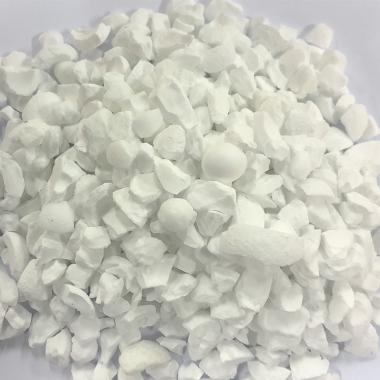Study on the production Technology and Properties of White Sintered Tabular Alumina
Jan 10, 2022
The production Technology and Properties of White Sintered Tabular Alumina
Sintered tabular corundum is produced by rapid ultra-high temperature sintering without any additives and over 1800 ℃. Its microscopic observation is a fully developed hexagonal plate-like α-alumina crystal, and the grain size is generally greater than 200 μm. White Sintered Tabular Alumina has excellent volume stability and thermal shock resistance, mainly due to its low open porosity and large crystals with closed intragranular pores formed during rapid sintering.

Production of white Sintered Tabular Alumina
1) Ball Mill
Continuous grinding of high-quality alumina powder, after reaching a certain fineness, is helpful for the sintering process.
2) into a ball
The finely ground powder is formed into balls with a ball-forming disc. The green balls are required to have a certain strength so as not to break during transport to the dryer. Through the process optimization design, the problems of high moisture content, easy delamination and difficult drying of semi-finished balls are solved.
3) Dry
The green balls enter the dryer to be dried to remove moisture. It is necessary to strictly control the temperature to avoid cracks and delamination inside the blank ball, as well as problems such as agglomeration and furnace blockage, which will block the flow of the ball and affect the drying quality.
4) Sintering
The green balls enter the shaft kiln after drying. The sintering temperature is about 1900°C. By adjusting the ratio of liquefied petroleum gas and wind power, a fully developed tabular corundum structure can be obtained. After cooling, inspection, crushing and screening, products of different particle sizes can be obtained. Carry out the inspection of qualified product particle bulk density, apparent porosity and water absorption.
Properties of white Sintered Tabular Alumina
The basic physical properties of White Sintered Tabular Alumina include bulk density, apparent porosity and water absorption. The produced sintered tabular corundum has a bulk density of 3.68 g/cm3, an apparent porosity of less than 3%, and a water absorption rate of less than 0.8%. Sintered tabular corundum contains large corundum crystals and open pores that cannot be observed with the naked eye, so the apparent porosity is low. Bulk density and water absorption are closely related to pores. If the product is under-burned and over-burned, a large number of open pores will appear, resulting in an increase in water absorption and a decrease in bulk density. Therefore, the firing process of the product should be strictly controlled in the production process.
In addition, it has extremely high refractoriness, excellent mechanical strength and wear resistance, excellent creep resistance and peeling resistance, very high chemical purity, excellent dielectric properties and corrosion resistance of acid and alkali, can It is widely used in steel, casting and ceramics industries, and can also be used in insulators, kiln furniture and catalyst carriers, etc., and can replace high energy consumption fused corundum.
Conclusion
White Sintered Tabular Alumina was successfully prepared by ultra-high temperature shaft kiln process. Microscopic observation found that the sintered tabular corundum formed a plate-like structure, and there were a large number of circular closed pores in the crystal, and the diameter of the closed pores was less than 10 μm and the grain size was 20 μm ~ 200 μm. The physical property test shows that the bulk density of the produced sintered tabular corundum is 3.68g/cm3, the apparent porosity is less than 3%, and the water absorption rate is less than 0.8%.
Relevant information
-

Main properties of magnesium oxide refractory
Performance characteristics of magnesia refractories and other basic refractories Performance characteristics of magnesia refractories and other basic refractories Refractories containing more than 80% ... -

What properties of lightweight insulation fire clay bricks can be improved by the addition of kyanite?
Lightweight insulation fire clay bricks are a kind of shaped refractory material with clay as the main raw material, which is processed, shaped, dried, and calcined with clay. on the kiln. Due to the r ... -

How is the effect of white fused alumina abrasive used in refractory materials?
After mixing, forming, drying, and firing at high temperature in a shuttle kiln. The product has the characteristics of high refractoriness, good thermal shock stability of white corundum, high high te ... -

Characteristics of refractory magnesia chrome bricks for lime kiln
Lime kilns are mainly classified into square kilns and circular kilns. According to the classification of fired products, they can be divided into lime kilns, ceramic kilns, cement kilns, glass kilns, ...

